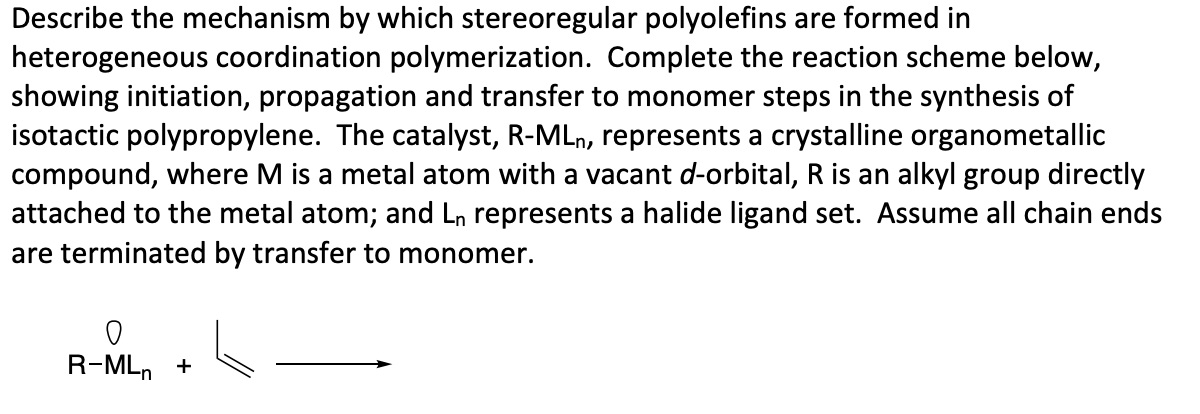Describe the mechanism by which stereoregular polyolefins are formed in heterogeneous coordination polymerization. Complete the reaction scheme below, showing initiation, propagation and transfer to monomer steps in the synthesis of isotactic polypropylene. The catalyst, R-MLn, represents a crystalline organometallic compound, where M is a metal atom with a vacant d-orbital, R is an alkyl group directly attached to the metal atom; and Ln represents a halide ligand set. Assume all chain ends are terminated by transfer to monomer. R-MLn +
Describe the mechanism by which stereoregular polyolefins are formed in heterogeneous coordination polymerization. Complete the reaction scheme below, showing initiation, propagation and transfer to monomer steps in the synthesis of isotactic polypropylene. The catalyst, R-MLn, represents a crystalline organometallic compound, where M is a metal atom with a vacant d-orbital, R is an alkyl group directly attached to the metal atom; and Ln represents a halide ligand set. Assume all chain ends are terminated by transfer to monomer. R-MLn +
Chemistry & Chemical Reactivity
10th Edition
ISBN:9781337399074
Author:John C. Kotz, Paul M. Treichel, John Townsend, David Treichel
Publisher:John C. Kotz, Paul M. Treichel, John Townsend, David Treichel
Chapter23: Carbon: Not Just Another Element
Section: Chapter Questions
Problem 4PS
Related questions
Question

Transcribed Image Text:Describe the mechanism by which stereoregular polyolefins are formed in
heterogeneous coordination polymerization. Complete the reaction scheme below,
showing initiation, propagation and transfer to monomer steps in the synthesis of
isotactic polypropylene. The catalyst, R-MLn, represents a crystalline organometallic
compound, where M is a metal atom with a vacant d-orbital, R is an alkyl group directly
attached to the metal atom; and Ln represents a halide ligand set. Assume all chain ends
are terminated by transfer to monomer.
R-MLn +
Expert Solution
This question has been solved!
Explore an expertly crafted, step-by-step solution for a thorough understanding of key concepts.
Step by step
Solved in 2 steps with 2 images

Knowledge Booster
Learn more about
Need a deep-dive on the concept behind this application? Look no further. Learn more about this topic, chemistry and related others by exploring similar questions and additional content below.Recommended textbooks for you

Chemistry & Chemical Reactivity
Chemistry
ISBN:
9781337399074
Author:
John C. Kotz, Paul M. Treichel, John Townsend, David Treichel
Publisher:
Cengage Learning

Chemistry & Chemical Reactivity
Chemistry
ISBN:
9781337399074
Author:
John C. Kotz, Paul M. Treichel, John Townsend, David Treichel
Publisher:
Cengage Learning